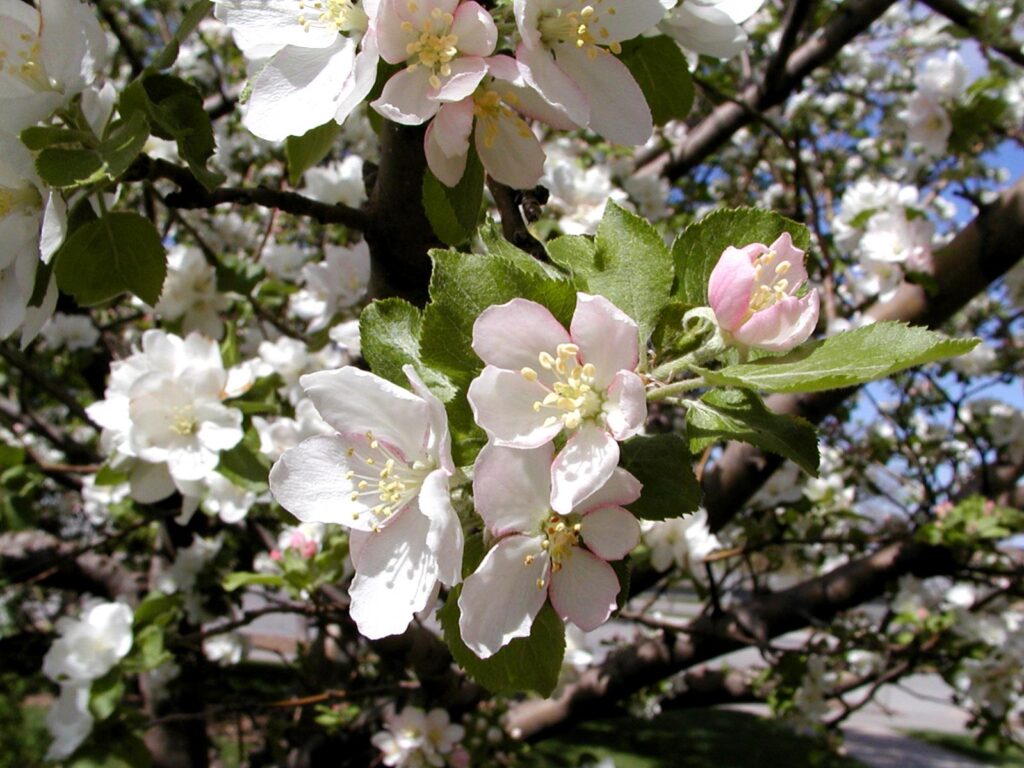Growing Fruit Trees
- 2022-03-04
- By mkirk
- Posted in Horticulture, The Garden Buzz
By Lucinda Greene, Colorado Master Gardener
Interest in backyard gardening has increased significantly since the pandemic. In addition to adding or updating outdoor recreational and entertaining spaces, families are adding spaces for growing both fruits and vegetables. If you are thinking about adding some fruit trees to your home landscape, here are some factors to consider and tips for success.

Select a good site. Like selecting any tree for the landscape, be sure to plan for the mature size of the tree. For best production, fruit trees need adequate spacing for good air circulation. Colorado is often subject to late spring frosts which can damage blossoms. The northeast corner of the home is the slowest to warm up in the spring. A tree sited here will come out of dormancy later in the season. Cold air drains downward. Plant fruit trees high on a slope, if available. Fruit trees are prone to root rot. They like well-drained, loamy soil. For best success, do not plant trees in heavily irrigated lawns, especially with clay soils. Avoid highly alkaline soils with pH above 7.5.
Select appropriate cultivars and rootstocks. Select the fruit tree variety for the desired use: eating, baking, canning, or preserving. Because of unpredictable Colorado weather with late spring and early fall frosts, select cultivars that bloom later and fruit earlier. Although we are zone 5, consider zone 4 cultivars for hardiness. Of the tree fruits that can be planted in a backyard setting, apple trees generally bloom the latest and thus are the easiest fruit to grow in our area.
All fruit trees are grafted. The rootstock determines the mature size, disease resistance, soil tolerance, cold hardiness, and drought tolerance of the tree. For most home gardens, dwarf or semi-dwarf varieties are most suitable for ease of fruit picking, pruning, and management. It is best to purchase trees from reputable, local nurseries or mail order nurseries who can provide rootstock information. Bare-root trees (whips) can be shipped and planted in mid-April from online sources. There are multiple mail order nurseries in the Upper Midwest or the Pacific Northwest.
Apricots, sour cherry, peach, nectarine, and European plum trees are self-pollinating. Apple, sweet cherry, pear, and Japanese plum trees are cross-pollinated. If growing one of these types, plant an additional fruit tree or an ornamental variety within 100 feet.

Plan for pest and disease management. Fruit trees are subject to many common pests and diseases including bacterial infections like fireblight, fungal infections like Cytospora canker and powdery mildew, and pests like coddling moth and various borers. Wildlife like deer, rabbits and voles can also affect fruit production. The first step in management is to select disease-resistant cultivars. Proper pruning practices can prevent the spread of fireblight. Appropriate annual spraying can help manage other pests. Proper chemical application and timing of the sprays is important. For more information, see Fact Sheet 2.800 or Fact Sheet 2.804.
Plan for regular pruning and other maintenance. Appropriate pruning of fruit trees will increase fruit production and reduce potential damage from disease organisms. Follow many of the same rules as for other landscape trees. Remove dead or diseased branches and remove internal branches that cross or interfere with one another to increase air and light circulation. Remove branches with narrow crotch angles that will not stand up to a heavy fruit load. Prune in late winter or early spring, just before bud break. If managing fireblight, be sure to disinfect pruners between each cut. For more detailed information on pruning fruit trees, see Fact Sheet 7.003. Mulch applied around the base of the tree will help retain important soil moisture in the root zone. Keep mulch six inches away from the trunk to deter burrowing pests like voles. Many fruit trees need regular fertilization of nitrogen and other nutrients to continue tree growth and fruit production. Check annual shoot growth or do a soils test to determine proper fertilizer applications. For more information on fertilization, see Fact Sheet 7.612. Wrap young trees annually each winter to protect thin bark from sunscald.
Enjoy the harvest!
Horticulture Resources
- Garden Buzz Archives
- CSU Extension Resources
- Colorado Master Gardener Program
- Foothills to Plains Native Plant Master Program
- Native Bee Watch Community Science Program
- The Co-Hort Blog
- PlantTalk Colorado
- Soil Testing
- Plant Select
- Emerald Ash Borer
- Japanese Beetle
- Colorado State Forest Service
- Ask an Expert


